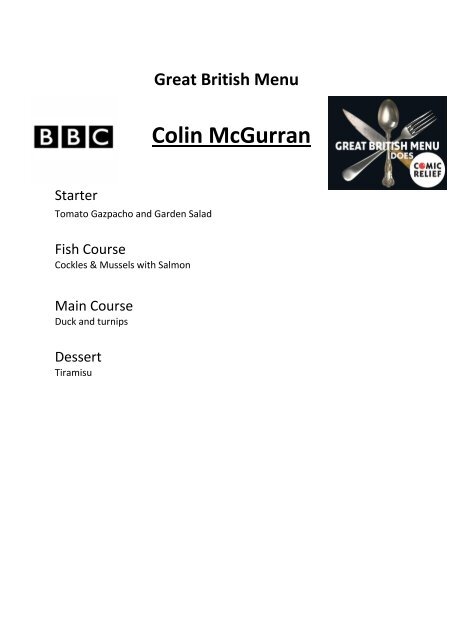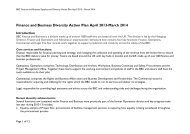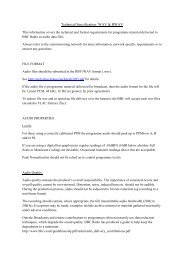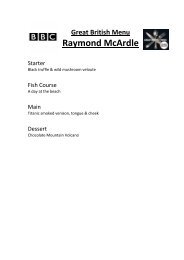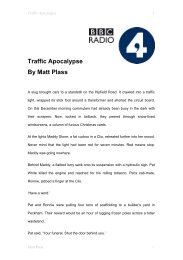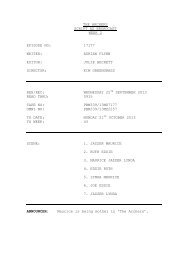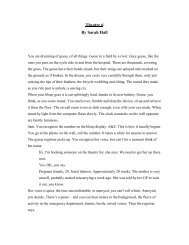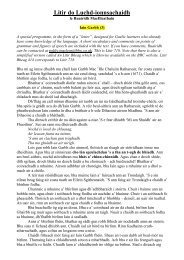Great British Menu Colin McGurran - BBC
Great British Menu Colin McGurran - BBC
Great British Menu Colin McGurran - BBC
Create successful ePaper yourself
Turn your PDF publications into a flip-book with our unique Google optimized e-Paper software.
Starter<br />
Tomato Gazpacho and Garden Salad<br />
Fish Course<br />
Cockles & Mussels with Salmon<br />
Main Course<br />
Duck and turnips<br />
Dessert<br />
Tiramisu<br />
<strong>Great</strong> <strong>British</strong> <strong>Menu</strong><br />
<strong>Colin</strong> <strong>McGurran</strong>
Starter<br />
Tomato Gazpacho and Garden Salad<br />
SERVES 4<br />
Ingredients<br />
For the salt mix<br />
15g/½oz rosemary leaves, finely chopped<br />
15g/½oz thyme leaves, finely chopped<br />
30g/1oz salt<br />
For the tomato gazpacho – makes enough for 8, make extra in case they don’t work 1 st time<br />
500g/17½oz plum tomatoes, quartered<br />
10g/½oz Salt mix<br />
20g/¾oz garlic, grated<br />
10g/½oz Vegetable oil<br />
200g/7oz Red peppers<br />
30g/1oz Tomato puree<br />
40g/1½oz Celery<br />
1 red chilli<br />
350g/12½oz Tomato juice<br />
20g/¾oz Icing sugar<br />
15g/½oz Raspberry vinegar<br />
40ml/1½floz White wine vinegar<br />
150g/5oz Olive oil<br />
20g/¾oz Beetroot<br />
6 leaves gelatine, pre-soaked in water<br />
30g/1oz Egg white powder<br />
For the tomato skin gel<br />
1kg/2½lb ripe tomatoes<br />
30g/1oz Vege gel<br />
1g Agar Agar<br />
50g/1¾oz Tomato puree<br />
10 drops Red food colouring<br />
1g Sea salt<br />
To make the fake tomatoes<br />
4-8 fresh tomato stalks from the top of tomatoes<br />
For the shallot rings<br />
1 x large shallot, sliced into rings<br />
100ml/3½floz Vinegar<br />
For the bread crisp<br />
200g/7oz Plain flour<br />
100ml/3½floz Warm water<br />
2g Sea salt<br />
For the cod brandade<br />
200g/7oz cod<br />
50g/17½oz Salt mix<br />
350g/12½oz Baking potatoes
100g/3½oz Cream<br />
100g/3½oz Milk<br />
For the poaching liquor<br />
25g/1oz Butter<br />
1 Onion<br />
3 Garlic<br />
2 Bay leaves<br />
1 sprig Thyme<br />
250ml/9floz Milk<br />
For the garnish<br />
Large handful of mixed garden leaves<br />
Method<br />
1. For the salt mix, place the ingredients into a bowl and combine<br />
2. For the tomato gazpacho, preheat the oven to 70C/160F (or the lowest possible<br />
setting), place the tomatoes into a roasting tray mix them with the salt mix, garlic,<br />
vegetable oil and bake in the oven for 1-1½ hours.<br />
3. Place the red peppers, tomato puree, celery, chilli, tomato juice, icing sugar,<br />
raspberry vinegar, white wine vinegar, olive oil and beetroot into a food processor<br />
with the tomato mix from above and blend for 1 minute, then cover and chill in the<br />
fridge for 24 hours. Pass the mixture through a sieve and reserve the liquid<br />
4. In a pan, bring to the boil 200ml/7floz of the gazpacho mix. Dissolve the gelatine in<br />
the mix and cool down to about 50C/120F. Then using a fine sieve, whisk in the egg<br />
powder until dissolved. Mix this with 1litre/1¾pts of the gazpacho mix and chill for<br />
12 hours until set<br />
5. Remove chilled mix from the fridge and whisk until it has a mousse consistency.<br />
Place 2 large squares of cling film on top of each other and place a 35g/1oz portion<br />
of the mix in the centre, bring up the edge and tie tightly around the mix, repeat for<br />
the remaining mix, tie these to a wooden spoon and hang in the freezer, from your<br />
shelf top or drawer for 12 hours until set<br />
6. For the tomato skin gel, place the tomatoes into a food processor and blend to a<br />
puree, place the pureed tomatoes into the centre of a square of muslin bring up the<br />
corners to form a bag and tie to a wooden spoon, hang in the fridge for about 1 hour<br />
and place a bowl under to collect the liquid<br />
7. Measure out 500ml/17½floz of the tomato water collected and place into a pan with<br />
the vege gel, agar agar, tomato puree, red food colouring and sea salt, bring to the<br />
boil, then keep on a gentle simmer until you have dipped all the ‘tomatoes’<br />
8. To make the fake tomatoes, unwrap the frozen tomato gazpacho’s and place a<br />
cocktail in the top centre, dip using the cocktail stick into the hot tomato skin gel 4<br />
times, place onto a non-stick tray, remove cocktail stick and place real tomato stalk<br />
on top. Leave to defrost for 30 minutes and keep in fridge for no longer than 24<br />
hours<br />
9. For the shallot rings, take 20 rings from shallot and place into the vinegar for 20<br />
minutes, then take out and leave to one side ready to serve<br />
10. For the bread crisp, mix all ingredients in a bowl, by hand and knead like pasta until<br />
smooth. Roll out very thin, then cut out 4 rough rectangles about 10cm x 5cm/4in x
2in. Heat a frying pan with a little oil and fry the bread quickly on both sides until<br />
golden<br />
11. For the cod brandade, place the cod onto a small tray and cover with the salt mix,<br />
leave for 12 hours in the fridge. Wash the salt off the cod under a running tap for 5<br />
minutes.<br />
12. Preheat the oven to 200C/400F/gas mark 6, place the baking potatoes directly onto<br />
the shelf in the oven and bake for 1¼-1½ hours, depending on the size of the potato.<br />
When cooked, scoop out the potato, weigh out 250g/9oz and mash to a fine mash,<br />
adding the milk and cream to get the correct mash consistency.<br />
13. Place the ingredients for the poaching liquor into a sauce pan and heat to a simmer,<br />
place the cod in and cook for 10 minutes.<br />
14. Place the cod into a food processor with the mash and blend for 1 minute, adding<br />
some of the cooking liquor if needed, until you have a puree<br />
15. Garnish the dish with an assortment of garden leaves
Fish Course<br />
Cockles & Mussels with Salmon<br />
SERVES 4<br />
Ingredients<br />
For the salmon<br />
1 large side of salmon<br />
200g/7oz coarse sea salt<br />
400ml/14floz vegetable oil<br />
For the horseradish cream<br />
300g/10½oz creamed horseradish (jar)<br />
100g/3½oz Cream<br />
For dashi stock<br />
5ltr/8½pts water<br />
20g/¾oz Bonito shavings<br />
300g/10½oz Bonito essence<br />
5 Kombu sheets<br />
10g/½oz Salt<br />
For the dashi jelly<br />
500ml/17½floz dashi stock<br />
3 gelatine leaves, pre-soaked for 5 minutes in water<br />
For the oyster emulsion<br />
75g/2½oz fresh oysters<br />
75g/2½oz egg whites<br />
230g/8oz vegetable oil<br />
15ml/½floz lemon Juice<br />
Small pinch sea salt<br />
For the herb emulsion<br />
50g/1¾oz Flat leaf parsley<br />
50g/1¾oz Dill<br />
50g/1¾oz Tarragon<br />
50g/1¾oz Chicken stock<br />
200g/7oz Olive oil<br />
Salt and freshly ground black pepper<br />
For the salmon tartare<br />
400ml/14floz vegetable oil<br />
1 shallot, sliced<br />
180g/6½oz Salmon, finely chopped<br />
80g/3oz cucumber, finely chopped<br />
25g/1oz Bonito essence or if unattainable, soya sauce<br />
15g/½oz Nori dressing, available in health shops<br />
Small pinch salt<br />
Freshly ground pepper to taste<br />
For the mussels and cockles<br />
500ml/17½floz water
300g/10½oz Fresh cockles<br />
200g/7oz Fresh mussels<br />
4g Agar Agar<br />
Method<br />
1. For the salmon, place the salmon onto a tray and sprinkle over the salt, leave for 20<br />
minutes. Wash the salmon in running water, then reserve in the fridge for 8-12<br />
hours. Cut the salmon into 4 pieces, keeping 180g/6½oz back for the salmon tartare.<br />
2. Place the oil into a deep, heavy bottomed pan and heat to 50C/120F. Place the 4<br />
salmon pieces into the oil and confit for 10 minutes, checking the temperature<br />
constantly to keep it as close to 50C/120F as possible.<br />
3. For the horseradish cream, mix the creamed horseradish and cream together in a<br />
bowl, pass through a sieve and place into 4 small moulds of your choosing, place into<br />
the freezer for 2 hours to set.<br />
4. For the dashi stock, place all the ingredients into a saucepan, bring to the boil, allow<br />
to cool slowly, then pass through muslin or very fine sieve.<br />
5. For the dashi jelly, warm the dashi stock, but do not boil, add the gelatine, pour into<br />
4 moulds of your choosing and leave to set for 2 hours.<br />
6. For the oyster emulsion, place the oysters and egg whites into a small bowl and<br />
blend with a hand blender until smooth. Slowly add the vegetable oil whilst still<br />
blending, to create an emulsion, then pass through a fine sieve, season with the<br />
lemon juice and salt then blend again.<br />
7. For the herb emulsion, place the herbs and chicken stock into a food processor and<br />
begin to blend, whilst blending slowly add the olive oil to create an emulsion. Season<br />
with salt and pepper to taste<br />
8. For the salmon tartare, place the oil into a deep, heavy bottomed pan and heat to<br />
180C/355F, add the shallots and cook until golden brown. Drain on kitchen towel<br />
and finely chop, measure out 10g/½oz for the tartare. Finally, mix all the ingredients<br />
together in a bowl<br />
9. For the mussels and cockles, place the water into a steamer pan, add the cockles and<br />
mussels to the steamer tray and cook until the mussels have opened. Place the<br />
cockles and mussels to one side and measure out 400ml/14floz of the steamer<br />
water, add the agar agar and dissolve through.<br />
10. Pick the flesh from the cockles and reserve. Pick the flesh from the mussel shells, add<br />
a spoon of the salmon tartare to the mussel shell, dip the mussels in the liquor, leave<br />
to set for 5 minutes, then place the mussel on top of the salmon tartare in the shell.
Main Course<br />
Duck and turnips<br />
SERVES 4<br />
Ingredients<br />
For duck sauce<br />
2-3 duck carcasses<br />
25ml/1floz Grapeseed oil<br />
25g/1oz Unsalted butter<br />
50g/1½oz Shallots, finely sliced<br />
2 Star Anise, crushed<br />
300ml/10½floz Chicken stock<br />
Pinch black peppercorns, crushed<br />
30ml/1floz Madeira<br />
12g/½oz Chervil, leaves and stems<br />
12g/½oz Parsley, leaves and stems<br />
Dash Armagnac<br />
For the salt mix<br />
15g/½oz rosemary leaves, finely chopped<br />
15g/½oz thyme leaves, finely chopped<br />
200g/7oz salt<br />
For the miso glaze mix<br />
250g/9oz miso paste<br />
250g/9oz olive oil<br />
For the duck legs<br />
6 Duck legs<br />
500ml-750ml/17½floz-26½floz Duck fat<br />
For the breasts<br />
4 Duck breasts, skin on<br />
For the duck hearts<br />
20 duck hearts<br />
For the turnip winter garnish<br />
2 Turnips<br />
1 White cabbage, sliced<br />
24 Brussel sprouts, halved<br />
12 Baby turnips, leaves still on, sliced in 2<br />
Garnish<br />
12 Blackberries<br />
Method<br />
11. For the duck sauce, place the duck carcasses in a pan of water and bring to the boil.<br />
As soon as it boils, take out the carcasses, chop them into small pieces and quickly<br />
rinse the carcasses. Heat a small amount of grapeseed oil in a large pressure cooker<br />
until very hot and fry the carcasses until browned. Deglaze with a small amount of<br />
water, then remove the carcasses from pan, drain and set aside. Add butter, shallots<br />
and star anise to the pressure cooker and cook on a medium heat, deglazing from
time to time with a little water to stop the shallots from catching and burning, until<br />
caramelised. Return the carcasses to the pressure cooker and cover with chicken<br />
stock, top up with water if it doesn’t cover. Add peppercorns, seal pressure cooker,<br />
bring to full pressure and cook for 2 hours.<br />
12. Leave the pressure cooker to cool before opening, then skim the fat from the<br />
surface. Pass the stock through a fine sieve into a rectangular container. Skim fat<br />
from the top and pass stock through a fine sieve lined with a double layer of damp<br />
muslin. Cover and chill in the fridge for 1 hour. When chilled, remove any fat that has<br />
solidified on the surface, transfer stock to a tray and freeze overnight until solid.<br />
13. Line a perforated tray/steamer pan with a double layer of muslin large enough to<br />
hold the frozen stock in a single flat layer.<br />
14. Once the stock is frozen, dip the bottom of the tray briefly in warm water to loosen,<br />
and turn out into the perforated tray, set this over a large container to catch the<br />
stock as it defrosts, and place in the fridge to thaw very slowly over 36-48 hours.<br />
15. Discard the gelled mass left in the top tray.<br />
16. Bring most of the Madeira (leaving a dash) to a simmer and set alight. Let the flame<br />
burn out and reduce alcohol by half. Add reduced Madeira to defrosted stock and<br />
place over a bowl of iced water to chill quickly. When cold add the herbs and place in<br />
a sealed container in the fridge for 12 hours. Strain stock and add remaining Madeira<br />
and Armagnac. Chill until needed<br />
17. For the salt mix, place the ingredients into a bowl and combine<br />
18. For the miso glaze mix, whisk together the ingredients in a bowl.<br />
19. For the duck legs, place the legs onto a tray and cover them with the salt mix, leave<br />
for 6 hours in the fridge, then rinse the salt off. Pre heat the oven to 90C/195F (or<br />
the lowest possible setting), place the duck legs into a high sided roasting tray and<br />
add the duck fat to cover.<br />
20. Cover the pan with cling film and place into the oven for 3½-4 hours<br />
21. Remove the roasting tray from the oven and when cool enough, take out the duck<br />
legs and pull the meat off bone, place a large square of cling film onto a work surface<br />
and cover with another piece of cling film, place the leg meat along the edge of the<br />
clingfilm and then roll tightly into a sausage. Tie the ends of the cling film tightly and<br />
place into the fridge to chill for 1 hour.<br />
22. Just before service, pour the miso glaze mix into a pan and bring up to low heat, slice<br />
4 x 3cm/1in thick slices of the duck leg sausage and slowly reheat them in the miso<br />
glaze sauce, basting continuously until warmed through.<br />
23. For the breasts, preheat the oven to 150C/300F/gas mark 2, heat a shallow pan and<br />
add the duck breasts skin side down, pan fry until the skin side is sealed and nicely<br />
brown then transfer to the oven and cook for 20 minutes. Remove the duck breasts<br />
and with a sharp knife, carefully remove the skin from the breast.<br />
24. For the duck hearts, heat a little oil in a shallow pan and fry the hearts for 2-3<br />
minutes, then leave to one side to rest for 2 minutes. Slice, and just before serving,<br />
place into the miso glaze mix with duck leg discs to warm<br />
25. For the turnip winter garnish, preheat the oven to 180C/350F/gas mark 4, place the<br />
turnips into a baking tray with a little oil, cover with foil and bake for 1 hour. Leave<br />
the turnips to one side to cool, then slice into discs<br />
26. Place the white cabbage into a steamer and steam for 20 minutes.<br />
27. Place the brussel sprouts into a pan of boiling water and blanche for 2 minutes.
28. Heat a little oil in a frying pan, and fry the baby turnips until golden on all sides.
Dessert<br />
Tiramisu<br />
SERVES 4<br />
Ingredients<br />
For the mascarpone mix<br />
5 Egg yolks<br />
170g/6oz Sugar<br />
300g/10½oz Mascarpone cheese<br />
5 egg whites<br />
50ml/1½floz Amaretto<br />
For the sponge fingers<br />
30 Sponge lady fingers<br />
250ml/9floz Strong coffee<br />
For assembly of the tiramisu<br />
20 thin chocolate discs about 2in in diameter<br />
For the red chocolate coating<br />
500g/17½oz White chocolate<br />
500g/17½oz Cocoa butter<br />
20ml/¾floz Red food colouring<br />
For the chocolate and coffee milkshake<br />
300ml/10½floz freshly made black coffee<br />
300ml/10½floz double cream<br />
30g/1oz sugar<br />
To garnish the plate<br />
80g/3oz Grated dark chocolate<br />
Moulds<br />
Available online http://www.patoncalvert.co.uk/coolcook/cup.html<br />
Method<br />
1. For the mascarpone mix, beat the egg yolks and 85g/3oz sugar until pale and fluffy,<br />
add mascarpone cheese and fold in. Whisk egg whites with the other half of the<br />
sugar until stiff peaks. Fold whites into egg yolk mixture, slowly adding the Amaretto.<br />
2. For the sponge fingers, dip sponge fingers into coffee for 2 seconds and remove.<br />
3. To assemble the Tiramisu, using 4 x 5cm/2in deep cup silicon muffin moulds, star<br />
with a layer of sponge fingers, then mascarpone mix, then a chocolate disc, repeat<br />
until you reach the top of your mould. Place into the freezer and leave to freeze for<br />
12 hours.<br />
4. For the red chocolate coating, place a glass mixing bowl over a hot pan of water,<br />
place in the white chocolate and cocoa butter and slowly stir until completely melted<br />
then mix in the food colouring<br />
5. Remove the frozen layered Tiramisu’s from the moulds and dip them into the warm<br />
red chocolate/cocoa butter mixture, stand upright on a sheet of greaseproof paper<br />
and allow to defrost for 30-45minutes.<br />
6. For the chocolate and coffee milkshake, place the coffee, cream and sugar into a pan<br />
and bring to the boil, whisk together and pour into a serving jug.
7. Decorate a plate with grated chocolate and place on the fez, serve with a jug of the<br />
chocolate and coffee milkshake


